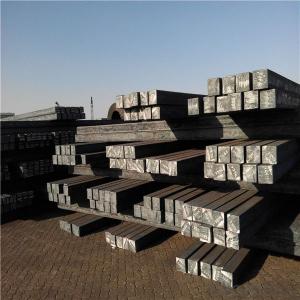Hot rolled Carbon Steel Billets Square Billets
- Loading Port:
- Tianjin
- Payment Terms:
- TT OR LC
- Min Order Qty:
- 1000 m.t.
- Supply Capability:
- 16021 m.t./month
OKorder Service Pledge
OKorder Financial Service
You Might Also Like
Item specifice
Steel billet :
Rectangular billet continuous casting billet and mainly general carbon steel, low carbon low silicon cold-rolled material, high quality carbon structural steel, high strength low alloy steel, special steel, etc.
The billet is mainly divided into two kinds from the shape:
Slab: cross section width and height of the ratio of the larger, mainly used for rolling plate.
Gade:
Standard | C(%) | Mn(%) | S(%) | P(%) | Si(%) |
Q195 | ≤0.12 | ≤0.50 | ≤0.040 | ≤0.035 | ≤0.30 |
Q235 | ≤0.20 | ≤1.40 | ≤0.045 | ≤0.045 | ≤0.35 |
Q275 | ≤0.22 | ≤1.50 | ≤0.045 | ≤0.045 | ≤0.35 |
20MnSi | 0.17-0.25 | 1.2-1.6 | ≤ 0.050 | ≤ 0.050 | 0.40-0.80 |
3SP | 0.14-0.22 | 0.40-0.85 | ≤ 0.050 | ≤ 0.040 | 0.05-0.15 |
5SP | 0.28-0.37 | 0.50-1.00 | ≤ 0.050 | ≤ 0.040 | 0.15-0.30 |
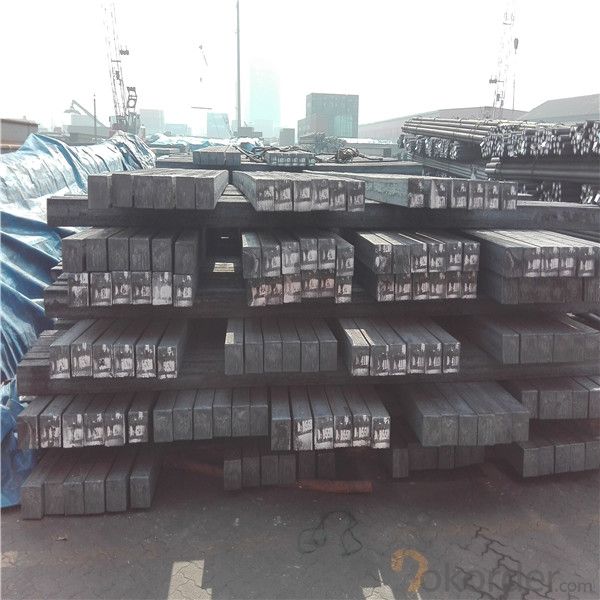
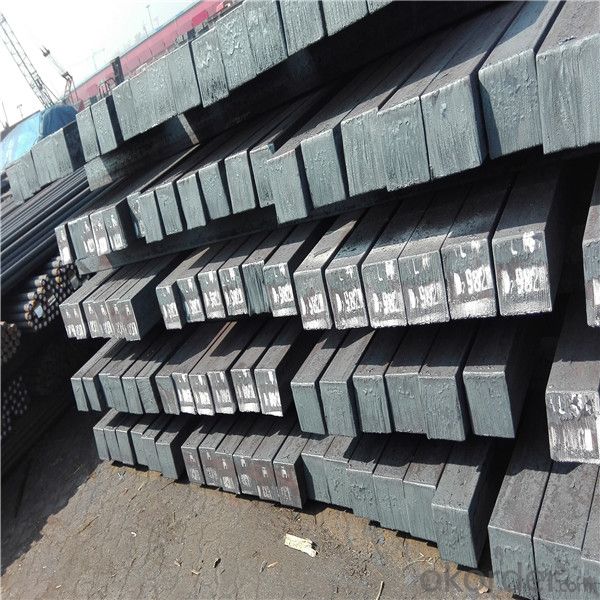
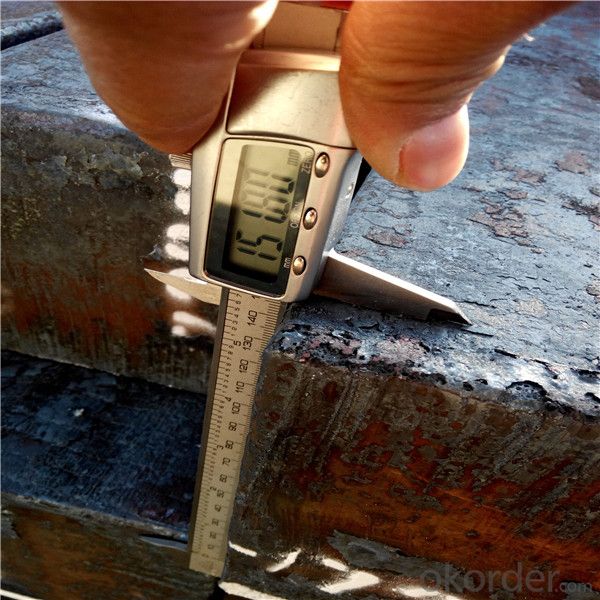
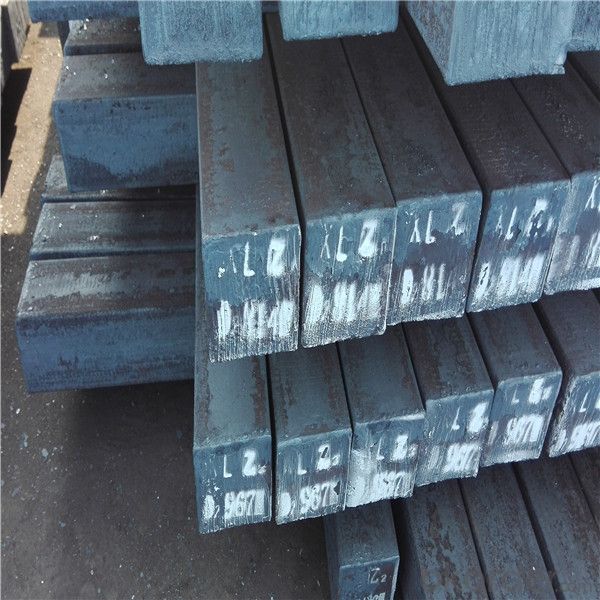
Other Specifications
Squar Tolerance: ±4
Length Tolerance: +100mm
Romboidity/Difference Diagonals: no more than 0.7%
Camber: no more than 1.5%(%)
Twist: no more than 3 degrees per 1 meter length
Our Advantage
* Professional Personnel of Steel Trading
* Strong Steel Industry Background
* Conveniently Geographic Location
Our Commitment
* Sincere, Practical, Efficient and Developing
* High Quality Steel Production
* Competitive Price and Timely Delivery
Packing :
Within 30 days
1.Standard export package
2.In bundles with steel strips
3.As the requirements of the customers
FAQ:
Q: How to get quotation?
A: When we receive your detailed enquiry, we will set the best price based on standard,
steel grade, outer diameter, wall thickness, quantity, country.
And we will send quotation to your mailbox.
Q:How to guarantee the quality of the products?
A:We have established the international advanced quality management system,every link from raw material
to final product we have strict quality test;We resolutely put an end to unqualified products flowing into the market.
At the same time, we will provide necessary follow-up service assurance.
Q:How long can we receive the product after purchase?
A :In the purchase of product within three working days, We will arrange the factory delivery as soon as possible.
The pecific time of receiving is related to the state and position of customers.
- Q:What are the different types of steel billet reheating furnaces?
- There are several types of steel billet reheating furnaces, including walking beam furnaces, pusher furnaces, rotary hearth furnaces, and roller hearth furnaces. Each type has its own advantages and uses, depending on the specific requirements of the steel production process.
- Q:What is the role of steel billets in the manufacturing of construction machinery?
- Steel billets play a crucial role in the manufacturing of construction machinery as they serve as the raw material for producing various components and structures. These billets are initially heated and then shaped or machined into different forms such as plates, beams, or rods, which are essential in constructing the frames, chassis, and other structural parts of construction machinery. The high strength and durability of steel make it ideal for withstanding heavy loads and harsh working conditions, ensuring the reliability and longevity of construction machinery.
- Q:What is the difference between steel billets and steel bars?
- Steel billets and steel bars are both raw forms of steel, but they differ in terms of their shapes and sizes. Steel billets are larger, rectangular-shaped semi-finished products that are typically used as input material for further processing, such as rolling or forging. On the other hand, steel bars are smaller, cylindrical-shaped finished products that have undergone additional processing, such as hot or cold rolling, to achieve a desired shape and size. In summary, steel billets are the starting point in the steel production process, while steel bars are the end products ready for use in various applications.
- Q:What are the different types of cleaning equipment used for steel billets?
- There are several different types of cleaning equipment that are commonly used for steel billets. These include: 1. Shot blasting machines: Shot blasting is a process that involves propelling small metal or mineral particles at high speed onto the surface of the steel billets. This helps to remove any rust, scale, or other contaminants, leaving the surface clean and smooth. 2. Ultrasonic cleaners: Ultrasonic cleaning involves the use of high-frequency sound waves to agitate a cleaning solution. This helps to remove dirt, oil, and other contaminants from the surface of the steel billets. Ultrasonic cleaners are particularly effective for removing stubborn or hard-to-reach contaminants. 3. Acid pickling tanks: Acid pickling is a process that involves immersing the steel billets in a tank of acidic solution. The acid helps to dissolve any rust, scale, or other contaminants on the surface of the billets. After pickling, the billets are usually rinsed and then dried. 4. Power washers: Power washers, also known as pressure washers, use a high-pressure spray of water to remove dirt, oil, and other contaminants from the surface of the steel billets. This is a particularly effective method for cleaning larger or heavier billets. 5. Mechanical cleaning brushes: Mechanical cleaning brushes, such as wire brushes or abrasive pads, are often used to manually scrub the surface of the steel billets. This helps to remove any loose dirt, rust, or scale. Mechanical cleaning brushes are typically used in conjunction with other cleaning methods. Overall, the choice of cleaning equipment for steel billets depends on factors such as the extent and type of contaminants present, the desired level of cleanliness, and the size and shape of the billets. Different combinations of these cleaning methods may be used to achieve the desired result.
- Q:What is the cost of producing steel billets?
- The production cost of steel billets can vary depending on different factors, such as the quality of the raw materials used, the production process employed, and the market conditions. Typically, the cost of producing steel billets includes several components. Firstly, there is the cost of raw materials, which usually consist of iron ore, coal or coke, and other alloying elements. The prices of these materials can change due to global market dynamics and availability. Secondly, the cost of energy is a significant factor in steel billet production. This includes the cost of electricity and fuel needed for the manufacturing process, such as powering the blast furnaces or electric arc furnaces used to melt the raw materials. Thirdly, labor costs play a crucial role in the overall production cost. This includes wages for skilled and unskilled workers involved in operating the machinery, maintaining equipment, and overseeing the production process. In addition, there are indirect costs that need to be taken into account, such as expenses for machinery maintenance and repair, transportation costs for raw materials and finished products, and overhead costs related to administrative functions. It is important to note that external factors like government regulations, tariffs, and taxes can also influence the production cost of steel billets. Furthermore, market demand and competition can impact pricing strategies and ultimately affect production costs. Therefore, providing an exact cost figure for producing steel billets is challenging due to constant fluctuations. It is best to consult industry experts or steel manufacturers for the most accurate and up-to-date information on production costs.
- Q:How are steel billets forged into shape?
- Steel billets are forged into shape through a process called hot forging, which involves heating the billet to a specific temperature and then applying pressure to shape it using a forging press or hammer. This process helps to refine the grain structure of the steel, improving its strength and mechanical properties.
- Q:What are the specifications for alloy steel billets used in the defense industry?
- The specifications for alloy steel billets used in the defense industry vary depending on the specific application and requirements of each project. However, there are certain common specifications that are typically followed. Firstly, the alloy steel billets used in the defense industry must meet stringent material standards and be certified to specific military or industry specifications. These standards often include requirements for the chemical composition, mechanical properties, and heat treatment of the alloy steel. The chemical composition of the alloy steel billets is crucial, as it determines the material's strength, hardness, and resistance to corrosion and high temperatures. The specific composition may vary depending on the intended use, but common alloying elements include chromium, molybdenum, vanadium, and nickel. Additionally, the carbon content is carefully controlled to achieve the desired strength and toughness. In terms of mechanical properties, alloy steel billets for defense applications generally need to have high strength, toughness, and impact resistance. They should be able to withstand extreme conditions, including high pressure, shock, and vibrations. The billets may undergo specific heat treatments, such as quenching and tempering, to achieve the desired mechanical properties. The dimensional specifications for alloy steel billets used in the defense industry are also crucial. They must meet precise size and shape tolerances, as well as surface finish requirements, to ensure compatibility with the manufacturing processes and final products. Furthermore, the billets may need to be certified to specific industry or military standards, such as MIL-STD or ASTM specifications, to ensure their suitability and reliability for defense applications. These standards define the testing methods, quality control requirements, and performance criteria that the alloy steel billets must meet. Overall, the specifications for alloy steel billets used in the defense industry encompass a range of factors, including chemical composition, mechanical properties, dimensional tolerances, and adherence to industry or military standards. These specifications are essential to ensure the performance, durability, and safety of the final defense products.
- Q:What are the main challenges in steel billet production?
- There are several main challenges in steel billet production that manufacturers and producers face. One of the key challenges is ensuring consistent and uniform quality of the billets. Steel billets are the semi-finished products that are further processed into various steel products, and any inconsistency or variation in their quality can lead to defects or failures in the final products. Therefore, maintaining strict quality control measures throughout the production process is crucial. Another significant challenge is optimizing the production process to meet the desired quantity and quality targets while minimizing costs. This involves efficient utilization of resources such as raw materials, energy, and labor. Additionally, maintaining a balance between the production speed and quality can be challenging as increasing the speed may lead to reduced quality or increased defects. Ensuring the safety of workers and the environment is also a major challenge in steel billet production. The production process involves heavy machinery, high temperatures, and potentially hazardous materials, which can pose risks to the workers' health and safety. Implementing proper safety protocols, providing training, and ensuring compliance with regulatory standards are essential to address these challenges. Furthermore, meeting the ever-increasing demand for steel billets is a challenge for producers. The market demand fluctuates, and manufacturers need to be able to adjust their production capacity accordingly. This requires flexibility in production planning and efficient inventory management to avoid overproduction or stock shortages. Lastly, technological advancements and innovations in the steel industry pose both challenges and opportunities. Adopting new technologies, such as automation, artificial intelligence, and data analytics, can improve efficiency and productivity. However, incorporating these technologies into existing production processes can be complex and require significant investments and expertise. In summary, the main challenges in steel billet production include maintaining consistent quality, optimizing production processes, ensuring safety, meeting market demand, and adapting to technological advancements. Overcoming these challenges requires continuous improvement, innovation, and a proactive approach to stay competitive in the steel industry.
- Q:What are the main factors that determine the profitability of steel billets manufacturers?
- There are several key factors that impact the profitability of steel billets manufacturers. These factors can vary depending on market conditions and industry dynamics. However, determining profitability in this sector involves considering certain main factors: 1. Raw material costs: The cost of raw materials, such as iron ore and scrap metal, greatly affects profitability. Fluctuations in these costs can influence the overall cost structure of steel billet production. Manufacturers who have efficient procurement strategies and long-term raw material contracts may have a competitive advantage in managing these costs. 2. Production efficiency: The efficiency of the manufacturing process plays a vital role in profitability. This includes factors like production capacity utilization, energy consumption, labor productivity, and waste management. Manufacturers who can optimize their operations and minimize costs are more likely to achieve higher profitability. 3. Market demand and pricing: The demand for steel billets is influenced by factors like construction activity, infrastructure development, and manufacturing output. Manufacturers who can accurately forecast and meet market demand are better positioned to achieve profitability. Additionally, the ability to negotiate favorable pricing and manage price fluctuations can significantly impact profitability. 4. Competitive landscape: The level of competition within the steel billets manufacturing industry can affect profitability. Manufacturers operating in a highly competitive market may face challenges in maintaining profit margins due to price pressures. Companies that can differentiate themselves through innovation, quality, and customer service may have a better chance of achieving sustainable profitability. 5. Operating costs: In addition to raw material costs, other operating expenses like transportation, energy, maintenance, and overhead costs can impact profitability. Efficient cost management practices, such as implementing lean manufacturing principles and optimizing supply chain logistics, can help reduce operating costs and improve profitability. 6. International trade and tariffs: Steel billets manufacturers are often impacted by international trade dynamics and tariffs. The imposition of tariffs on steel imports or exports can disrupt the market and impact profitability. Manufacturers who can adapt to changes in trade policies and diversify their customer base or sourcing locations may be better positioned to mitigate these risks. 7. Currency exchange rates: Steel billets manufacturers engaged in international trade may be exposed to currency exchange rate fluctuations. These fluctuations can impact the cost of imported raw materials or the competitiveness of exported products. Manufacturers who have effective currency hedging strategies or local production capabilities may be better able to manage these risks and maintain profitability. In conclusion, the profitability of steel billets manufacturers is influenced by various factors, including raw material costs, production efficiency, market demand, competition, operating costs, international trade dynamics, and currency exchange rates. Successful manufacturers in this industry must carefully analyze and manage these factors to achieve sustainable profitability.
- Q:How are steel billets used in the manufacturing of furniture?
- Steel billets are used in the manufacturing of furniture as a raw material for various components such as frames, legs, and supports. They are often shaped, cut, and welded to create the desired structural elements of furniture pieces, providing strength, durability, and stability to the final product.
1. Manufacturer Overview |
|
|---|---|
| Location | |
| Year Established | |
| Annual Output Value | |
| Main Markets | |
| Company Certifications | |
2. Manufacturer Certificates |
|
|---|---|
| a) Certification Name | |
| Range | |
| Reference | |
| Validity Period | |
3. Manufacturer Capability |
|
|---|---|
| a)Trade Capacity | |
| Nearest Port | |
| Export Percentage | |
| No.of Employees in Trade Department | |
| Language Spoken: | |
| b)Factory Information | |
| Factory Size: | |
| No. of Production Lines | |
| Contract Manufacturing | |
| Product Price Range | |
Send your message to us
Hot rolled Carbon Steel Billets Square Billets
- Loading Port:
- Tianjin
- Payment Terms:
- TT OR LC
- Min Order Qty:
- 1000 m.t.
- Supply Capability:
- 16021 m.t./month
OKorder Service Pledge
OKorder Financial Service
Similar products
New products
Hot products
Hot Searches
Related keywords
